

Compact Muon Solenoid
LHC, CERN
| CMS-EXO-18-013 ; CERN-EP-2019-280 | ||
| Search for an excited lepton that decays via a contact interaction to a lepton and two jets in proton-proton collisions at ${\sqrt{s}} = $ 13 TeV | ||
| CMS Collaboration | ||
| 13 January 2020 | ||
| JHEP 05 (2020) 052 | ||
| Abstract: Results are presented from a search for events containing an excited lepton (electron or muon) produced in association with an ordinary lepton of the same flavor and decaying to a lepton and two hadronic jets. Both the production and the decay of the excited leptons are assumed to occur via a contact interaction with a characteristic energy scale $\Lambda$. The branching fraction for the decay mode under study increases with the mass of the excited lepton and is the most sensitive channel for very heavy excited leptons. The analysis uses a sample of proton-proton collisions collected by the CMS experiment at the LHC at ${\sqrt{s}} = $ 13 TeV, corresponding to an integrated luminosity of 77.4 fb$^{-1}$. The four-body invariant mass of the two lepton plus two jet system is used as the primary discriminating variable. No significant excess of events beyond the expectation for standard model processes is observed. Assuming that $\Lambda$ is equal to the mass of the excited leptons, excited electrons and muons with masses below 5.6 and 5.7 TeV, respectively, are excluded at 95% confidence level. These are the best limits to date. | ||
| Links: e-print arXiv:2001.04521 [hep-ex] (PDF) ; CDS record ; inSPIRE record ; CADI line (restricted) ; | ||
| Figures | |

png pdf |
Figure 1:
Feynman diagram for the production of an excited lepton in association with an SM lepton in a hadron collider. The excited lepton decays via a contact interaction to one SM lepton and two resolved jets, which result from the hadronization of the quarks. |

png pdf |
Figure 2:
Branching fractions, $\mathcal {B}$, of excited lepton decay channels as a function of the ratio of the excited lepton mass $({M_{\ell ^*}})$ and compositeness scale ($\Lambda $) for fixed values of the model parameters $f=f'$, which represent the couplings of excited leptons to SM particles. The branching fraction calculation is based on Ref. [6]. The contact interaction decay to one lepton and two jets, subject of this analysis, is dominating the region of high ${M_{\ell ^*}} /\Lambda $. Couplings $f$ and $f'$ are assumed to be equal to 1 in the left graph, and 0.1 in the right graph. |
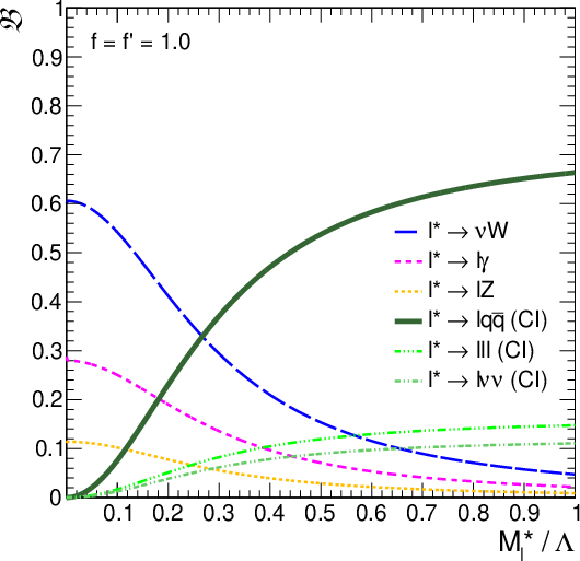
png pdf |
Figure 2-a:
Branching fractions, $\mathcal {B}$, of excited lepton decay channels as a function of the ratio of the excited lepton mass $({M_{\ell ^*}})$ and compositeness scale ($\Lambda $) for fixed values of the model parameters $f=f'$, which represent the couplings of excited leptons to SM particles. The branching fraction calculation is based on Ref. [6]. The contact interaction decay to one lepton and two jets, subject of this analysis, is dominating the region of high ${M_{\ell ^*}} /\Lambda $. Couplings $f$ and $f'$ are assumed to be equal to 1 in the left graph, and 0.1 in the right graph. |

png pdf |
Figure 2-b:
Branching fractions, $\mathcal {B}$, of excited lepton decay channels as a function of the ratio of the excited lepton mass $({M_{\ell ^*}})$ and compositeness scale ($\Lambda $) for fixed values of the model parameters $f=f'$, which represent the couplings of excited leptons to SM particles. The branching fraction calculation is based on Ref. [6]. The contact interaction decay to one lepton and two jets, subject of this analysis, is dominating the region of high ${M_{\ell ^*}} /\Lambda $. Couplings $f$ and $f'$ are assumed to be equal to 1 in the left graph, and 0.1 in the right graph. |
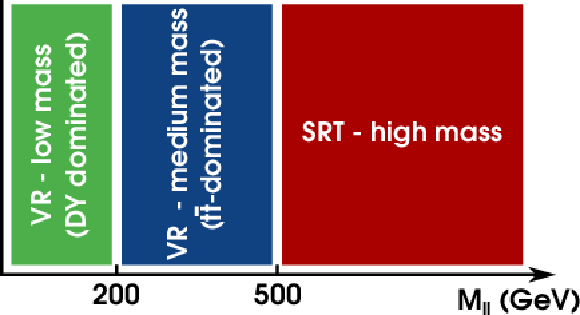
png pdf |
Figure 3:
Definition of the two validation regions (VR) and the high-mass signal region (SRT). |
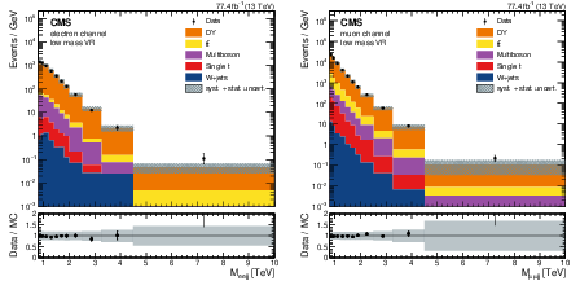
png pdf |
Figure 4:
Event distributions as a function of the four-body invariant $M_{{\ell \ell jj}}$ mass for the electron (left) and muon (right) channels, for the low-mass validation region defined by $M_{\ell \ell} < $ 200 GeV. The bin content is normalized to the width of the first bin, i.e., 100 GeV. The lower panels show the ratio of data to the simulated SM background, with the shaded band representing the uncertainty. |

png pdf |
Figure 4-a:
Event distributions as a function of the four-body invariant $M_{{\ell \ell jj}}$ mass for the electron (left) and muon (right) channels, for the low-mass validation region defined by $M_{\ell \ell} < $ 200 GeV. The bin content is normalized to the width of the first bin, i.e., 100 GeV. The lower panels show the ratio of data to the simulated SM background, with the shaded band representing the uncertainty. |

png pdf |
Figure 4-b:
Event distributions as a function of the four-body invariant $M_{{\ell \ell jj}}$ mass for the electron (left) and muon (right) channels, for the low-mass validation region defined by $M_{\ell \ell} < $ 200 GeV. The bin content is normalized to the width of the first bin, i.e., 100 GeV. The lower panels show the ratio of data to the simulated SM background, with the shaded band representing the uncertainty. |

png pdf |
Figure 5:
Event distribution as a function of the four-body invariant mass $M_{{\ell \ell jj}}$ for the electron (left) and muon (right) channels, for the medium-mass validation region defined by 200 $ < M_{\ell \ell} < $ 500 GeV. The bin content is normalized to the width of the first bin, i.e., 100 GeV. The lower panel shows the ratio of data to the simulated SM background, with the shaded band representing the uncertainty. |

png pdf |
Figure 5-a:
Event distribution as a function of the four-body invariant mass $M_{{\ell \ell jj}}$ for the electron (left) and muon (right) channels, for the medium-mass validation region defined by 200 $ < M_{\ell \ell} < $ 500 GeV. The bin content is normalized to the width of the first bin, i.e., 100 GeV. The lower panel shows the ratio of data to the simulated SM background, with the shaded band representing the uncertainty. |
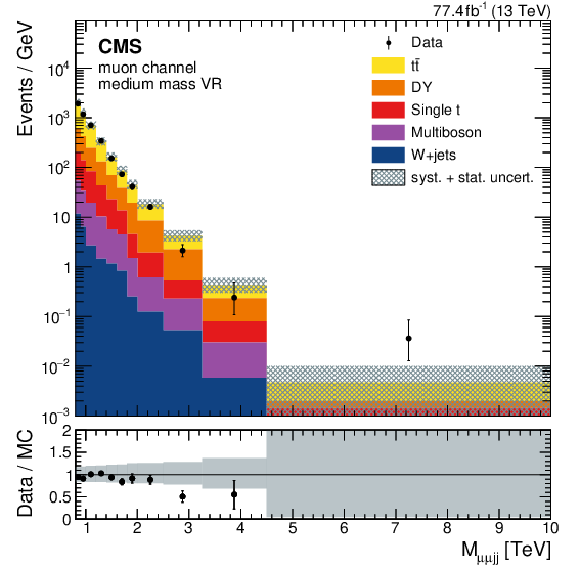
png pdf |
Figure 5-b:
Event distribution as a function of the four-body invariant mass $M_{{\ell \ell jj}}$ for the electron (left) and muon (right) channels, for the medium-mass validation region defined by 200 $ < M_{\ell \ell} < $ 500 GeV. The bin content is normalized to the width of the first bin, i.e., 100 GeV. The lower panel shows the ratio of data to the simulated SM background, with the shaded band representing the uncertainty. |
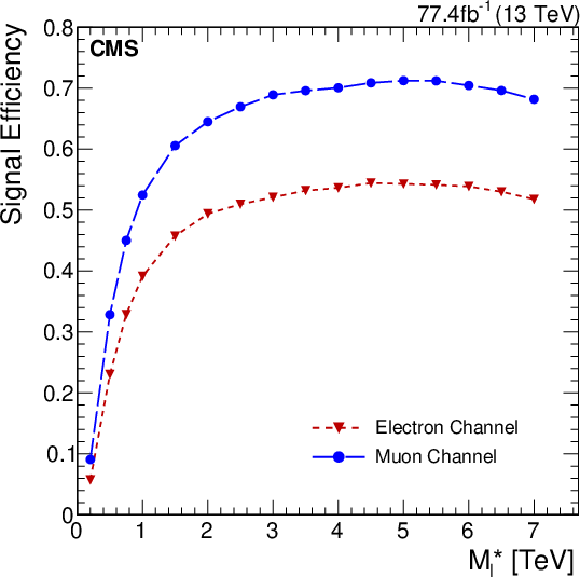
png pdf |
Figure 6:
Signal efficiency after all selections are applied, as a function of the excited lepton mass ${M_{\ell ^*}}$, based on simulated events. |
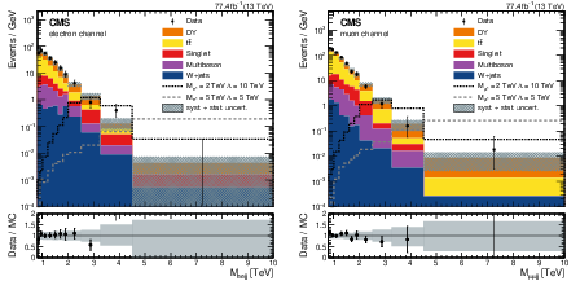
png pdf |
Figure 7:
Distribution of the two-lepton two-jet invariant mass in the signal region ($M_{\ell \ell} > $ 500 GeV) for the electron (left) and muon (right) channels. The example signal shape for two excited lepton masses is indicated as a gray line with the parameters given in the legend and for the benchmark case where the couplings $f$ and $f'$ are set to unity. The bin content is normalized to the width of the first bin, i.e., 100 GeV. The lower panels show the ratio of data to simulation with the total uncertainty in gray. |

png pdf |
Figure 7-a:
Distribution of the two-lepton two-jet invariant mass in the signal region ($M_{\ell \ell} > $ 500 GeV) for the electron (left) and muon (right) channels. The example signal shape for two excited lepton masses is indicated as a gray line with the parameters given in the legend and for the benchmark case where the couplings $f$ and $f'$ are set to unity. The bin content is normalized to the width of the first bin, i.e., 100 GeV. The lower panels show the ratio of data to simulation with the total uncertainty in gray. |
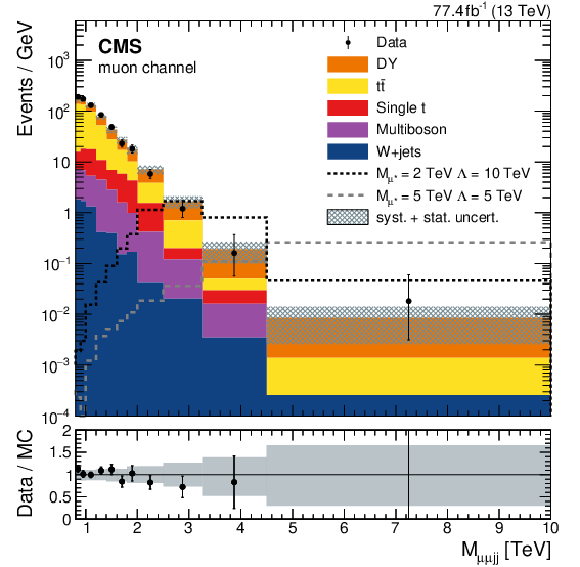
png pdf |
Figure 7-b:
Distribution of the two-lepton two-jet invariant mass in the signal region ($M_{\ell \ell} > $ 500 GeV) for the electron (left) and muon (right) channels. The example signal shape for two excited lepton masses is indicated as a gray line with the parameters given in the legend and for the benchmark case where the couplings $f$ and $f'$ are set to unity. The bin content is normalized to the width of the first bin, i.e., 100 GeV. The lower panels show the ratio of data to simulation with the total uncertainty in gray. |
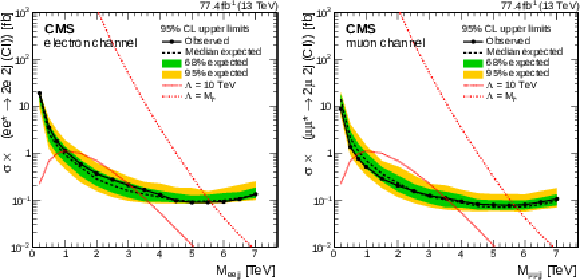
png pdf |
Figure 8:
Limits at 95% CL on the product of the production cross section and branching fraction for $\ell {\ell ^*} \to {\ell \ell jj} $, as a function of the invariant mass $M_{{\ell \ell jj}}$, for the electron (left) and muon (right) channels. The expectation from the model is represented for $ {| f |} = {| f' |} = $ 1 by two cases, $\Lambda = $ 10 TeV, and $\Lambda = {M_{\ell ^*}} $. |
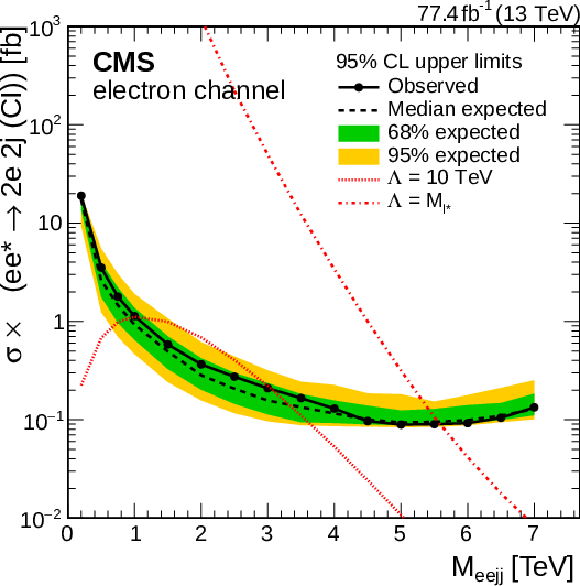
png pdf |
Figure 8-a:
Limits at 95% CL on the product of the production cross section and branching fraction for $\ell {\ell ^*} \to {\ell \ell jj} $, as a function of the invariant mass $M_{{\ell \ell jj}}$, for the electron (left) and muon (right) channels. The expectation from the model is represented for $ {| f |} = {| f' |} = $ 1 by two cases, $\Lambda = $ 10 TeV, and $\Lambda = {M_{\ell ^*}} $. |

png pdf |
Figure 8-b:
Limits at 95% CL on the product of the production cross section and branching fraction for $\ell {\ell ^*} \to {\ell \ell jj} $, as a function of the invariant mass $M_{{\ell \ell jj}}$, for the electron (left) and muon (right) channels. The expectation from the model is represented for $ {| f |} = {| f' |} = $ 1 by two cases, $\Lambda = $ 10 TeV, and $\Lambda = {M_{\ell ^*}} $. |

png pdf |
Figure 9:
Limits on the compositeness scale $\Lambda $ for the electron (left) and muon (right) channels, as a function of the mass of the excited lepton, for the benchmark case where the GI couplings $ {| f |}$ and $ {| f' |}$ are set to one. The model is not valid in the hatched area. |

png pdf |
Figure 9-a:
Limits on the compositeness scale $\Lambda $ for the electron (left) and muon (right) channels, as a function of the mass of the excited lepton, for the benchmark case where the GI couplings $ {| f |}$ and $ {| f' |}$ are set to one. The model is not valid in the hatched area. |

png pdf |
Figure 9-b:
Limits on the compositeness scale $\Lambda $ for the electron (left) and muon (right) channels, as a function of the mass of the excited lepton, for the benchmark case where the GI couplings $ {| f |}$ and $ {| f' |}$ are set to one. The model is not valid in the hatched area. |

png pdf |
Figure 10:
Limits on the compositeness scale $\Lambda $ for the electron (left) and muon (right) channels, as a function of the mass of the excited lepton, for the case where the GI couplings $ {| f |}$ and $ {| f' |}$ are set to 0.1. The model is not valid in the hatched area. |
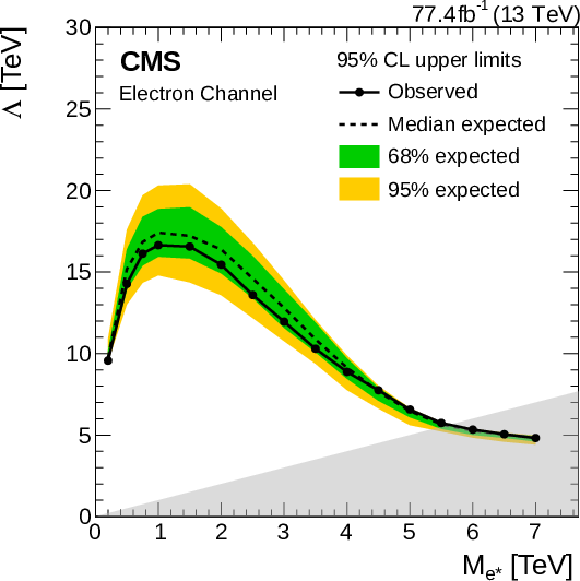
png pdf |
Figure 10-a:
Limits on the compositeness scale $\Lambda $ for the electron (left) and muon (right) channels, as a function of the mass of the excited lepton, for the case where the GI couplings $ {| f |}$ and $ {| f' |}$ are set to 0.1. The model is not valid in the hatched area. |

png pdf |
Figure 10-b:
Limits on the compositeness scale $\Lambda $ for the electron (left) and muon (right) channels, as a function of the mass of the excited lepton, for the case where the GI couplings $ {| f |}$ and $ {| f' |}$ are set to 0.1. The model is not valid in the hatched area. |

png pdf |
Figure 11-a:
Limits on the compositeness scale $\Lambda $ for the electron (left) and muon (right) channels, as a function of the mass of the excited lepton, for the benchmark case where the GI couplings $f$ and $f'$ vanish. The model is not valid in the hatched area. |
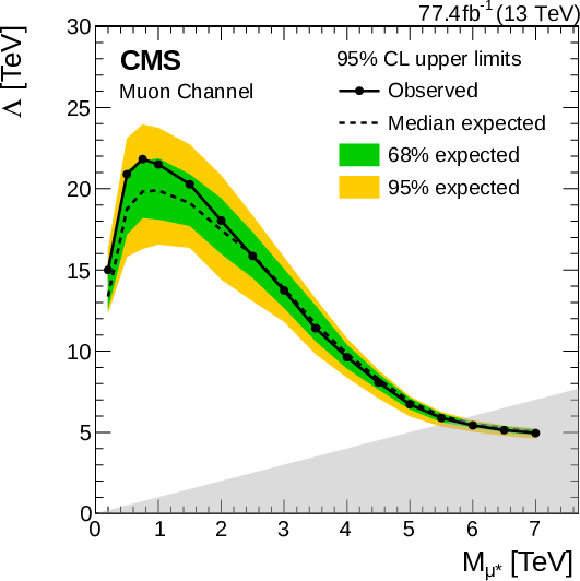
png pdf |
Figure 11-b:
Limits on the compositeness scale $\Lambda $ for the electron (left) and muon (right) channels, as a function of the mass of the excited lepton, for the benchmark case where the GI couplings $f$ and $f'$ vanish. The model is not valid in the hatched area. |
| Tables | |

png pdf |
Table 1:
Observed event yields in bins of four-body mass compared to the expected SM background, for the $2e2j$ and $2\mu 2j$ final states. Also shown are the expected event yields for two simulated signal samples with the given masses and couplings. All yields are given in bins of the discriminating four-body mass ($2\ell 2j$) distribution, with lower and upper value for each bin given in units of GeV. Systematic uncertainties, as described in the text, are shown. |

png pdf |
Table 2:
Summary of the observed (expected) limits on ${\ell ^*}$ mass, assuming ${M_{\ell ^*}} = \Lambda $, for the cases $f = f'$ and $f = -f'$. The limits evaluated in terms of the compositeness scale $\Lambda $ are shown in the right column. |
| Summary |
|
A search for excited leptons decaying via a contact interaction to final states of two electrons or two muons and two resolved jets has been performed. This channel complements other searches for excited leptons. It has greatest sensitivity at large values of the excited lepton mass $ {M_{\ell^*}} $. The data for this analysis were recorded with the CMS detector in the years 2016 and 2017, corresponding to a total integrated luminosity of 77.4 fb$^{-1}$ of proton-proton collisions at a center-of-mass energy of 13 TeV. No significant deviations from SM expectations are observed in the signal region and 95% exclusion limits have been set. Excited electrons (muons) up to masses of $M_{{\mathrm{e}^*} } = $ 5.6 TeV ($M_{\mu^{*}} = $ 5.7 TeV) are excluded with the usual assumption of ${M_{\ell^*}} = \Lambda$. These are the best limits to date. The limit was also re-evaluated in terms of the substructure scale $\Lambda$, leading to limits of $\Lambda = $ 11 and 12 TeV for excited electrons and muons, respectively, for mass values around 2 TeV and couplings of unity. When studying weaker gauge couplings, the limit on the maximum $ {M_{\ell^*}} $ does not change, but the larger cross section increases the $\Lambda$ sensitivity at lower masses. For couplings around zero, where the ${\ell\ell\gamma} $ decay has no sensitivity, limits around 20 TeV for the compositeness scale $\Lambda$ are achieved. |
| References | ||||
| 1 | J. C. Pati, A. Salam, and J. A. Strathdee | Are quarks composite? | PLB 59 (1975) 265 | |
| 2 | H. Terazawa, M. Yasu\`e, K. Akama, and M. Hayshi | Observable effects of the possible substructure of leptons and quarks | PLB 112 (1982) 387 | |
| 3 | E. Eichten, K. D. Lane, and M. E. Peskin | New tests for quark and lepton substructure | PRL 50 (1983) 811 | |
| 4 | H. Harari | Composite models for quarks and leptons | PR 104 (1984) 159 | |
| 5 | K. D. Lane, F. E. Paige, T. Skwarnicki, and W. J. Womersley | Simulations of supercollider physics | PR 278 (1997) 291 | hep-ph/9412280 |
| 6 | U. Baur, M. Spira, and P. M. Zerwas | Excited quark and lepton production at hadron colliders | PRD 42 (1990) 815 | |
| 7 | O. W. Greenberg and C. A. Nelson | Composite models of leptons | PRD 10 (1974) 2567 | |
| 8 | O. W. Greenberg and J. Sucher | A quantum structure dynamic model of quarks, leptons, weak vector bosons, and Higgs mesons | PLB 99 (1981) 339 | |
| 9 | S. Biondini, R. Leonardi, O. Panella, and M. Presilla | Perturbative unitarity bounds for effective composite models | PLB 795 (2019) 644 | 1903.12285 |
| 10 | ALEPH Collaboration | Search for excited leptons at 130--140 GeV | PLB 385 (1996) 445 | |
| 11 | DELPHI Collaboration | Search for composite and exotic fermions at LEP 2 | EPJC 8 (1999) 41 | hep-ex/9811005 |
| 12 | OPAL Collaboration | Search for unstable heavy and excited leptons at LEP 2 | EPJC 14 (2000) 73 | hep-ex/0001056 |
| 13 | L3 Collaboration | Search for excited leptons at LEP | PLB 568 (2003) 23 | hep-ex/0306016 |
| 14 | H1 Collaboration | Search for excited electrons in $ ep $ collisions at HERA | PLB 666 (2008) 131 | 0805.4530 |
| 15 | CDF Collaboration | Search for excited and exotic electrons in the $ \mathrm{e}\gamma $ decay channel in $ \rm {p}\overline{\rm p} $ collisions at $ \sqrt{s} = $ 1.96 TeV | PRL 94 (2005) 101802 | hep-ex/0410013 |
| 16 | CDF Collaboration | Search for excited and exotic muons in the $ \mu\gamma $ decay channel in $ \rm {p}\overline{\rm p} $ collisions at $ \sqrt{s} = $ 1.96 TeV | PRL 97 (2006) 191802 | hep-ex/0606043 |
| 17 | D0 Collaboration | Search for excited muons in $ {p}\overline{p} $ collisions at $ \sqrt{s} = $ 1.96 TeV | PRD 73 (2006) 111102 | hep-ex/0604040 |
| 18 | D0 Collaboration | Search for excited electrons in $ {p}\overline{p} $ collisions at $ \sqrt{s} = $ 1.96 TeV | PRD 77 (2008) 091102 | 0801.0877 |
| 19 | ATLAS Collaboration | Search for excited electrons and muons in $ \sqrt{s}= $ 8 TeV proton-proton collisions with the ATLAS detector | New J. Phys. 15 (2013) 093011 | 1308.1364 |
| 20 | ATLAS Collaboration | A search for an excited muon decaying to a muon and two jets in pp collisions at $ \sqrt{s} = $ 8 TeV with the ATLAS detector | New J. Phys. 18 (2016) 073021 | 1601.05627 |
| 21 | ATLAS Collaboration | Search for excited electrons singly produced in proton-proton collisions at $ \sqrt{s} = $ 13 TeV with the ATLAS experiment at the LHC | EPJC 79 (2019) 803 | 1906.03204 |
| 22 | CMS Collaboration | Search for excited leptons in pp collisions at $ \sqrt{s}= $ 7 TeV | PLB 720 (2013) 309 | CMS-EXO-11-034 1210.2422 |
| 23 | CMS Collaboration | Search for excited leptons in proton-proton collisions at $ \sqrt{s}= $ 8 TeV | JHEP 03 (2016) 125 | CMS-EXO-14-015 1511.01407 |
| 24 | CMS Collaboration | Search for excited leptons in $ \ell\ell\gamma $ final states in proton-proton collisions at $ \sqrt{s}= $ 13 TeV | JHEP 04 (2019) 015 | CMS-EXO-18-004 1811.03052 |
| 25 | CMS Collaboration | Performance of photon reconstruction and identification with the CMS detector in proton-proton collisions at $ \sqrt{s} = $ 8~TeV | JINST 10 (2015) P08010 | CMS-EGM-14-001 1502.02702 |
| 26 | CMS Collaboration | Search for heavy narrow dilepton resonances in pp collisions at $ \sqrt{s}= $ 7 TeV and $ \sqrt{s}= $ 8 TeV | PLB 720 (2013) 63 | CMS-EXO-12-015 1212.6175 |
| 27 | CMS Collaboration | Performance of the CMS muon detector and muon reconstruction with proton-proton collisions at $ \sqrt{s}= $ 13 TeV | JINST 13 (2018) P06015 | CMS-MUO-16-001 1804.04528 |
| 28 | CMS Collaboration | Particle-flow reconstruction and global event description with the CMS detector | JINST 12 (2017) P10003 | CMS-PRF-14-001 1706.04965 |
| 29 | CMS Collaboration | The CMS trigger system | JINST 12 (2017) P01020 | CMS-TRG-12-001 1609.02366 |
| 30 | CMS Collaboration | The CMS experiment at the CERN LHC | JINST 3 (2008) S08004 | CMS-00-001 |
| 31 | T. Sjostrand et al. | An introduction to PYTHIA 8.2 | Comp. Phys. Comm. 191 (2015) 159 | 1410.3012 |
| 32 | NNPDF Collaboration | Parton distributions with LHC data | NPB 867 (2013) 244 | 1207.1303 |
| 33 | NNPDF Collaboration | Parton distributions from high-precision collider data | EPJC 77 (2017) 663 | 1706.00428 |
| 34 | CMS Collaboration | Extraction and validation of a new set of CMS PYTHIA8 tunes from underlying-event measurements | EPJC 80 (2020) 4 | CMS-GEN-17-001 1903.12179 |
| 35 | M. Cacciari, G. P. Salam, and G. Soyez | The anti-$ {k_{\mathrm{T}}} $ jet clustering algorithm | JHEP 04 (2008) 063 | 0802.1189 |
| 36 | M. Cacciari, G. P. Salam, and G. Soyez | FastJet user manual | EPJC 72 (2012) 1896 | 1111.6097 |
| 37 | CMS Collaboration | Search for high-mass resonances in dilepton final states in proton-proton collisions at $ \sqrt{s}= $ 13 TeV | JHEP 06 (2018) 120 | CMS-EXO-16-047 1803.06292 |
| 38 | CMS Collaboration | Performance of CMS muon reconstruction in pp collision events at $ \sqrt{s}= $ 7 TeV | JINST 7 (2012) P10002 | CMS-MUO-10-004 1206.4071 |
| 39 | CMS Collaboration | Jet energy scale and resolution in the CMS experiment in pp collisions at 8 TeV | JINST 12 (2017) P02014 | CMS-JME-13-004 1607.03663 |
| 40 | J. Alwall et al. | The automated computation of tree-level and next-to-leading order differential cross sections, and their matching to parton shower simulations | JHEP 07 (2014) 079 | 1405.0301 |
| 41 | R. Frederix and S. Frixione | Merging meets matching in MadGraph5+MCatNLO | JHEP 12 (2012) 061 | 1209.6215 |
| 42 | R. Gavin, Y. Li, F. Petriello, and S. Quackenbush | FEWZ 2.0: A code for hadronic Z production at next-to-next-to-leading order | CPC 182 (2011) 2388 | 1011.3540 |
| 43 | P. Nason | A new method for combining NLO QCD with shower Monte Carlo algorithms | JHEP 11 (2004) 040 | hep-ph/0409146 |
| 44 | S. Frixione, P. Nason, and C. Oleari | Matching NLO QCD computations with parton shower simulations: the POWHEG method | JHEP 11 (2007) 070 | 0709.2092 |
| 45 | S. Alioli, P. Nason, C. Oleari, and E. Re | A general framework for implementing NLO calculations in shower Monte Carlo programs: the POWHEG BOX | JHEP 06 (2010) 043 | 1002.2581 |
| 46 | E. Re | Single-top W$ \itt-channel $ production matched with parton showers using the POWHEG method | EPJC 71 (2011) 1547 | 1009.2450 |
| 47 | S. Frixione, P. Nason, and G. Ridolfi | A positive-weight next-to-leading-order Monte Carlo for heavy flavour hadroproduction | JHEP 09 (2007) 126 | 0707.3088 |
| 48 | M. Czakon, P. Fiedler, and A. Mitov | Total top-quark pair-production cross section at hadron colliders through $ \mathcal{O}({{\alpha}}_{S}^{4}) $ | PRL 110 (2013) 252004 | |
| 49 | NNPDF Collaboration | Parton distributions for the LHC Run II | JHEP 04 (2015) 040 | 1410.8849 |
| 50 | S. Agostinelli et al. | GEANT4--a simulation toolkit | NIMA 506 (2003) 250 | |
| 51 | CMS Collaboration | Search for high-mass resonances in final states with a lepton and missing transverse momentum at $ \sqrt{s}= $ 13 TeV | JHEP 06 (2018) 128 | CMS-EXO-16-033 1803.11133 |
| 52 | CMS Collaboration | Performance of electron reconstruction and selection with the CMS detector in proton-proton collisions at $ \sqrt{s} = $ 8 TeV | JINST 10 (2015) P06005 | CMS-EGM-13-001 1502.02701 |
| 53 | CMS Collaboration | CMS Luminosity Measurements for the 2016 Data Taking Period | CMS-PAS-LUM-17-001 | CMS-PAS-LUM-17-001 |
| 54 | CMS Collaboration | CMS Luminosity Measurements for the 2017 Data Taking Period at $ \sqrt{s}= $ 13 TeV | CMS-PAS-LUM-17-004 | |
| 55 | CMS Collaboration | Measurement of the inelastic proton-proton cross section at $ \sqrt{s} = $ 13 TeV | JHEP 07 (2018) 161 | CMS-FSQ-15-005 1802.02613 |
| 56 | J. Butterworth et al. | PDF4LHC recommendations for LHC Run II | JPG 43 (2016) 023001 | 1510.03865 |
| 57 | A. Buckley et al. | LHAPDF6: parton density access in the LHC precision era | EPJC 75 (2015) 132 | 1412.7420 |
| 58 | Particle Data Group, M. Tanabashi et al. | Review of particle physics | PRD 98 (2018) 030001 | |

|
Compact Muon Solenoid LHC, CERN |

|

|

|

|

|

|